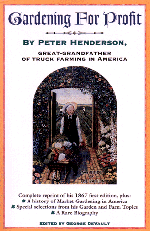Today I actually found the time to read. Gardening for Profit is buried somewhere in the moving boxes, but I did manage to bring along my copy of The Biological Farmer. I’ll finish posting notes for Gardening for Profit when I get back to Oregon, but now seems like a good time to start sharing what I’m learning from Gary Zimmer.
This author runs a sustainable agriculture consulting firm in the upper Midwest and this book was originally intended to be a primer for consultants-in-training. He also owns and operates a 500-acre organic crop and dairy farm, and manages a 240-acre livestock and crop demonstration farm. It sounds like he’s heavily influenced by Albrecht, so I’m using this book as an introduction to soil-focused agriculture.
Some of the information isn’t new to me, since I studied environmental science and ecology in school. My eyes didn’t perk up till chapter 2, when he described 6 rules essential to biological farming. By “biological” farming, he means farming to maximize productivity and profits over time by understanding and working with biological processes (whereas conventional practices focus on maximum productivity and profits ASAP, and don’t give a @#$% about biological processes). He goes a step further and describes his criteria for sustainable agriculture, which can be achieved by practicing biological agriculture properly and in the long run: zero soil loss, nutrient balance, and 25 earthworms per cubic foot of soil.
So here are the 6 basic rules essential to biological farming: Read the rest of this entry »

 Back to home page
Back to home page

 Save this page on Del.icio.us
Save this page on Del.icio.us